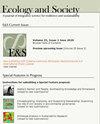当地生态知识和多学科方法导致在加拿大拉布拉多深海发现隐藏的生物多样性
IF 3.2
2区 社会学
Q1 ECOLOGY
引用次数: 0
摘要
保护全球生物多样性的国际承诺的目标是到2030年保护30%的海洋栖息地。由于对许多海洋区域(如深海)甚至缺乏基本知识,再加上时间紧迫,需要利用综合知识和多学科技术有效地确定值得保护的区域。在这里,我们概述了在加拿大拉布拉多沿海的一个深水槽中发现的马科维克空中花园的案例研究。该地区具有重要的生态意义,因为它支持高密度的脆弱海洋生态系统指标分类群,包括部分垂直海底壁上的柳珊瑚Primnoa resedaformis。该研究展示了Nunatsiavut发起的探索过程,该过程整合了当地知识,科学模型和各种技术(如远程操作车辆和多波束声纳),以发现深水隐藏的生物多样性,以推进当地土著和全球保护目标。本文章由计算机程序翻译,如有差异,请以英文原文为准。
Local ecological knowledge and multidisciplinary approach lead to discovery of hidden biodiversity in the deep ocean of Labrador, Canada
International commitments to preserve global biodiversity target the protection of 30% of marine habitats by 2030. The lack of even basic knowledge of many marine areas (e.g., deep oceans) combined with short timelines require integrative knowledge and multidisciplinary techniques to be used to efficiently identify areas worthy of protection. Here we outline a case study of the discovery of the Makkovik Hanging Gardens found in a deep-water trough in coastal Labrador, Canada. The area is of ecological significance because it supports high densities of vulnerable marine ecosystem indicator taxa, including the gorgonian coral Primnoa resedaeformis on portions of its vertical submarine walls. This study illustrates the exploratory process initiated by Nunatsiavut, which integrated local knowledge, scientific models, and a variety of technologies (such as remotely operated vehicles and multibeam sonar) to discover deep-water hidden biodiversity toward the advancement of both local Indigenous and global conservation goals.
求助全文
通过发布文献求助,成功后即可免费获取论文全文。
去求助
来源期刊

Ecology and Society
环境科学-生态学
CiteScore
6.20
自引率
4.90%
发文量
109
审稿时长
3 months
期刊介绍:
Ecology and Society is an electronic, peer-reviewed, multi-disciplinary journal devoted to the rapid dissemination of current research. Manuscript submission, peer review, and publication are all handled on the Internet. Software developed for the journal automates all clerical steps during peer review, facilitates a double-blind peer review process, and allows authors and editors to follow the progress of peer review on the Internet. As articles are accepted, they are published in an "Issue in Progress." At four month intervals the Issue-in-Progress is declared a New Issue, and subscribers receive the Table of Contents of the issue via email. Our turn-around time (submission to publication) averages around 350 days.
We encourage publication of special features. Special features are comprised of a set of manuscripts that address a single theme, and include an introductory and summary manuscript. The individual contributions are published in regular issues, and the special feature manuscripts are linked through a table of contents and announced on the journal''s main page.
The journal seeks papers that are novel, integrative and written in a way that is accessible to a wide audience that includes an array of disciplines from the natural sciences, social sciences, and the humanities concerned with the relationship between society and the life-supporting ecosystems on which human wellbeing ultimately depends.
 求助内容:
求助内容: 应助结果提醒方式:
应助结果提醒方式:


